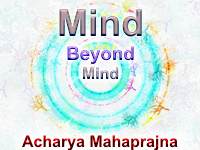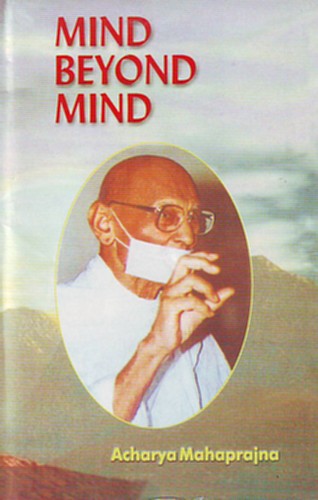
Looking at the tall trees standing in a garden, a visitor said to the gardener, 'These trees have grown very tall'. The gardener replied, 'They have nothing else to do except to grow tall.' We always think of doing some thing or the other. We believe that it is the nature of things to be active. There is nothing in the world, which does not do something. Every substance, whether it is animate or inanimate, conscious or unconscious, is active. We often tell ourselves, 'Let me not be idle; let me do some thing'. We extol those who work and condemn the idlers. That man must do some thing has become almost a dictum with us. The awareness that we are not idlers gives us a sense of pride and elevation. Being idle hurts our dignity. Every one dislikes idlers. Society is not prepared to accept idleness as a virtue. The world is running very fast and we have become too much involved in relentless activity. The important man frets to stay dynamic. We have become too much involved in a vicious circle of activity to appreciate the value of renunciation. Renunciation has come to be thought of as an empty ideal. We, however, forget that a blind devotion to activity has destroyed the peace of our minds. We have failed to appreciate the ideal of idleness, because we stand committed to the ideal of action. How to do away with this commitment has become the greatest problem of man today.
I know I am talking something unexpected. I may be expected to say some thing in praise of the philosophy of action. The time does not seem to be favourable to the cult of renunciation. Anyhow, let us not forget facts. Our preoccupation with action has done us immense harm. If we wish to regain peace and happiness, we will have to affect a balance between action and inaction. We will have to develop a realistic understanding of the philosophy of renunciation. Inaction is not less valuable than action. A proper appreciation of the value of inaction will enable us to understand the value of action in a better way and to avoid its harmful consequences. The Gita says that all our actions produce harmful results in the same way in which fire produces smoke. This can be avoided by affecting a compromise between action and inaction. We will have to go through the experience of remaining inactive, which we have not done as yet.
All our actions spring from the body. In order to be inactive we will have to abandon the body, to render it completely idle, so much so that our instincts cease to function. This is called Kayotsarga in Jain Yoga. It means complete immobilization of the body. It is, however, very difficult to abandon the body. Usually we abandon the body only when we die. But I am speaking of another kind of abandonment. It is abandoning the body even while we are living. Gautama asked Mahavira, 'What do we achieve by Kayagupti or the abandonment of the body?' The latter replied, 'Kayagupti results in Samvara.' There are two terms in Jain philosophy, Asrava and Samvara. The former means induction of foreign matter into the soul. The soul by its very nature is pure and uncontaminated. It becomes contaminated when foreign matter begins to enter into it. This can be avoided. Asrava can be stopped. By stopping it, we can preserve the pristine purity of the soul. By plugging of the sources of the induction of foreign matter into the soul, we produce a state of Samvara. It is a state in which nothing enters into the soul from outside.
It is through the body that the soul receives foreign matter. Heaps of atoms enter into the soul through mental action, speech and breathing. All this infiltration will stop if the body is immobilized. A state of total inactivity of the body is the state of meditation. The state of meditation is not exclusively a mental state. Jain Acaryas differ from other Acaryas of Yoga on this point, Jain Yoga has conceived of three kinds of meditation: body meditation, word meditation and mental meditation. Meditation is a state of mental and physical equilibrium. It is a state of physical equipoise also.
Meditation literally means contemplation. The meanings of words undergo contractions and extensions in the course of time. The extended meaning of a term is much more than its etymological significance. In the same way the extended meaning of the term meditation is much more than contemplation. It means fixing, equiponderate. It means fixing the body, mind and speech. A fixed mind enters into a state of meditation. Fixed speech becomes word meditation. Physical meditation is the base of all other meditations. The other forms of meditation are impossible without fixing the body. Word meditation must invariably be preceded by physical meditation. Mental meditation comes only after word meditation has been mastered. There can be no breath control without fixing the body, and meditation on the mental plane is impossible until respiration has been controlled. In this way Kayotsarga or Kayagupti is the base of meditation.
It is difficult to meditate on the mental plane. Physical meditation is comparatively easy. One who has mastered the fixing of the body can easily enter into a state of meditation. A strained body produces a tense mind, which is antithetical to meditation. To fix the body it is absolutely necessary to remove the tension of the mind. All the nerves and muscles, which constitute the brain, must be made supple. Stiff muscles and a stiff spinal cord produce obstructions in meditation. One must develop the capacity to make the body supple at will. This is a sadhana and a very useful one for meditation. Only a very few can accomplish this sadhana. It is only when the body, mind and speech have been completely fixed that we can enter into a state of meditation proper.
Those who are practising Avadhana may feel from what I have said that the state of meditation is far away from them. It is true that it is a long way away. But if they persist in practice, they will surely attain the end. If they succeed in collecting the wandering mind, they can also succeed in meditation. Success in Avadhana is not a small success. What else is Avadhana but the fixing or collection of the mind on a single point? Having mastered Kayotsarga, one can enter into Bhavana or the feeling of Being and then into meditation, even success in Kayotsarga is not a mean success. It is full of immense potential.
Physical tension is the greatest problem of man today. Ours is an age of exceptionally feverish activities. The result is tremendous loss of energy and vitality. If the modern man could learn how to fix his body and to control respiration, he would save himself from many pitfalls. Excessive engagements produce several kinds of diseases and mental deformities. Relaxation of the body can be a very good remedy for these diseases. Healthy breathing and the relaxation of the body are important means of success in sadhana. They have not only a physical but also a spiritual value.
The Sutrakrtanga raises the question as to who can exhaust the effects of Karma and who can remove deeply rooted predilections. It is the ignorant, who think that the effects of past Karma can be removed by fresh Karma (deeds). It is not possible to remove old predilections by creating fresh ones. The chain of actions has no end. Every action produces a reaction. Only inaction can break the vicious circle of actions. Those alone, who do so can acquire knowledge and comprehend truth. Inaction or renunciation is the only remedy. Predilections are born of our likes and dislikes and attachments. They are a Gordian knot, which can be cut by sobriety, forbearance and knowledge, which restrict the operation of Karma and its repetition. Predispositions and the repetition of Karma have overpowered us to such an extent that our minds have become stunted, peevish, restless and distressed. The time has come to examine this situation seriously otherwise our miseries will continue to multiply.
Industrialists and politicians often talk of the tremendous progress we have made in the field of material prosperity. Unfortunately what we call progress is motivated by our likes and dislikes and attachments and aversions to certain kinds of actions only. It implies continuously increasing hard work. Unplanned progress and industrialization have pushed us towards a wrong direction. We have come to be caught in a bewildering situation. We can develop a sense of direction only by evaluating renunciation properly and by enabling consciousness to function in a natural and healthy way.
The contemporary situation is the result of the conflict of values and a dichotomy between material gains and spiritual freedom. We will have to affect a proper balance between the two. Unfortunately, we have come to accept material achievements to be the highest ideal. This has produced dangerous consequences. From this it follows the need to understand and appreciate the value of Kayaguti or the control of the body.
The real progress of life depends not on action but on inaction. Too much involvement leaves us no time to think. There can be no happiness in life unless work and rest are properly balanced. Unfortunately, we do not pay any attention to the need for rest. Too much work has converted man into a ghost stalking in the night. Moreover, work has become too much exacting and this has completely disturbed the normal routine of life. Work and rest, action and inaction should not be allowed to overlap each other, if we want to avoid nervous tensions. Hectic activity has eclipsed consciousness. We need spare time to think and contemplate. No scientist can discover truth unless he has enough time for reflection. Flashes of intuitional knowledge visit the mind only when it is completely relaxed.
Inaction does not mean stopping of all activity. It means spiritual activity as contrasted with material activity. It implies a compromise between a purely subjective and a purely objective attitude of mind. Those who attend Yoga Strips might feel that these camps are meant for idlers. Every day in the camp might appear to be a day spent in inactivity. This is a misunderstanding and has got to be removed. If we could practice inactivity by appreciating it properly, we will be able to affect a balance in life. We have become so much absorbed in activity that we are not able to divide the day from the night. The entire natural course of life seems to have been reversed. What I mean by inaction is not giving up action totally. One who appears to be idle may be busy in his mind. Inaction does not mean physical idleness only. It has a positive content also. Consciousness is not a gross thing to be perceived by the eye. It is an active process, a stream, which flows on continuously. Spiritual activity produces enormous energy, which can bring about revolutionary changes in material life also. The Gita calls upon us to see action in inaction and vice versa. He alone who does so is a really wise man. The state of inaction is not a state of vacuum. What happens in moments of inaction is a very positive and valuable thing. We should not overlook this fact. Action produces more action and also miseries. In Kayagupti every limb and every muscle of the body is relaxed and fixed. You may lie down on the ground and spread your arms and legs in opposite directions. You should also go on imagining that the body is being immobilized. This is very important. The autosuggestion that the body is being relaxed is very highly valuable in sadhana.
 Acharya Mahaprajna
Acharya Mahaprajna

